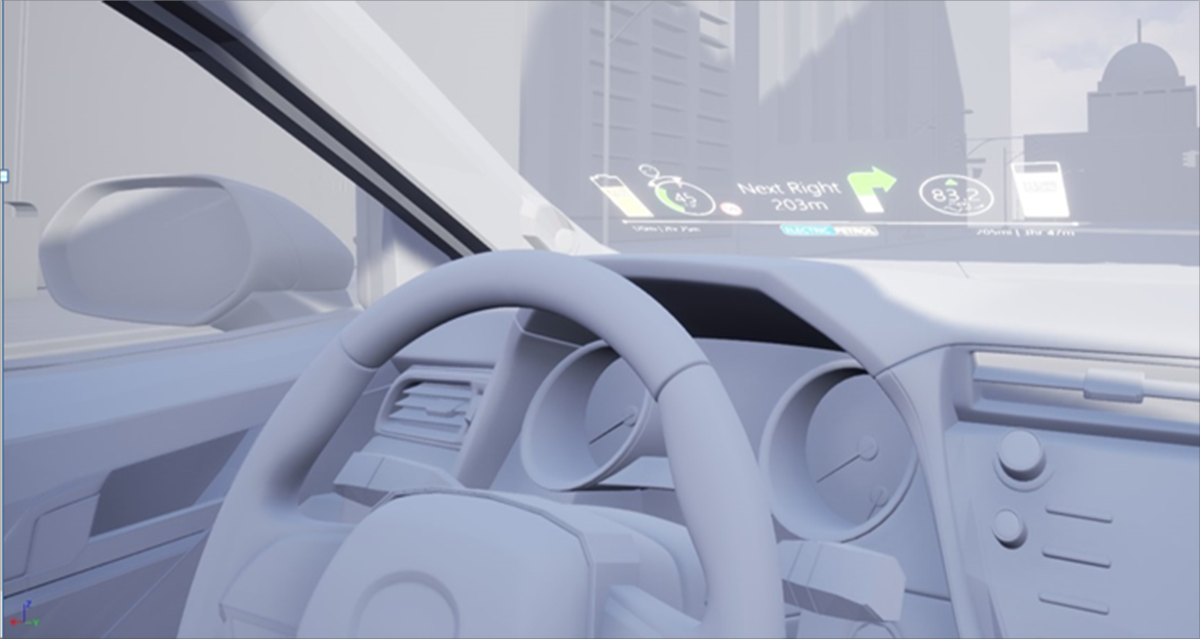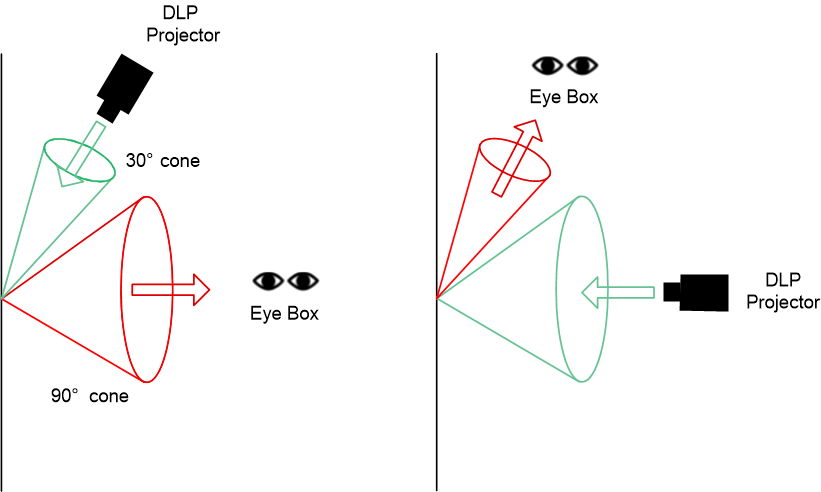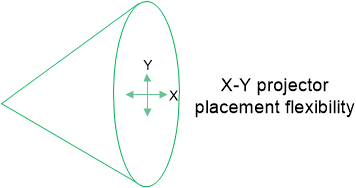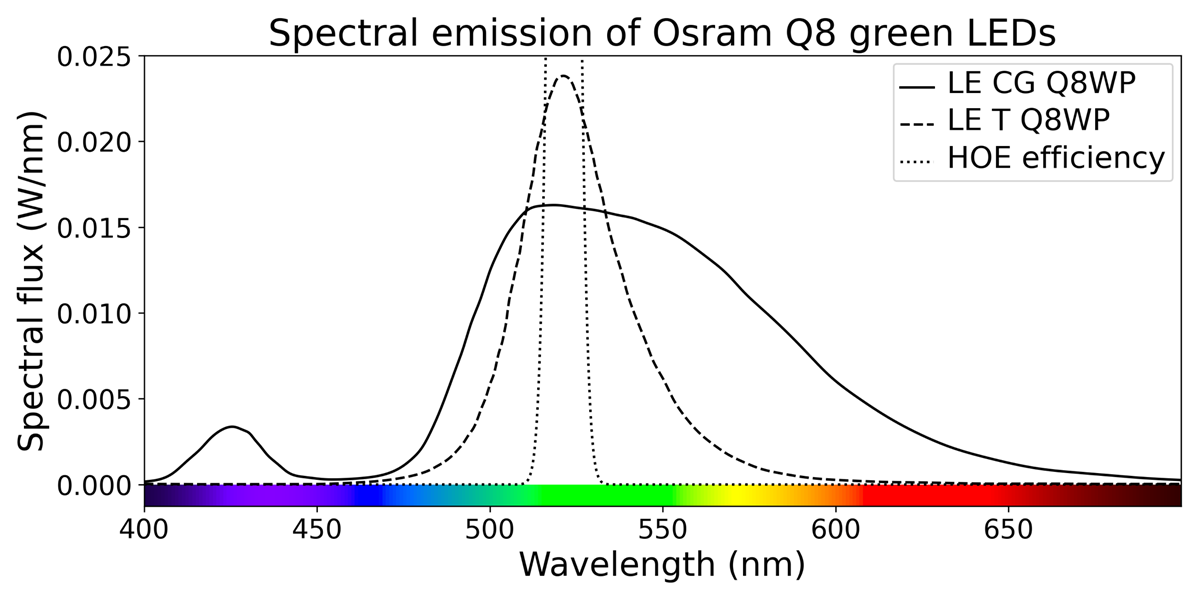DLPA118 January 2021 DLP3020-Q1 , DLP4620S-Q1 , DLP5530S-Q1
Technical White Paper
Turning the front windshield into a large interactive display has long been the goal of the automotive industry but, due to a number of technical challenges, has yet to be realized. One of the primary challenges has been the physical size of the projection optics and the limited amount of dash space to house that technology. To address this challenge, the automotive industry has been hard at work developing a number of new display technologies that significantly reduce package size.
One promising technology being considered is the in-plane (IP) holographic display, also known as an IP holographic optical element (HOE) display. The IP HOE display leverages advancements in digital holography to create a large transparent window display that requires minimal space for the supporting projection optics and electronics.
An IP holographic display can be placed on the front, side, or back window and designed to be viewed from either the interior or exterior of the vehicle. In this paper we will focus on the front windshield display which can display cluster, infotainment, and navigational information directly in the line of sight of the driver. Figure 1-1 shows an example of a windshield cluster display.
 Figure 1-1 Digital windshield cluster
(image courtesy of Ceres Holographics)
Figure 1-1 Digital windshield cluster
(image courtesy of Ceres Holographics)Introduction to IP HOE Displays
In a front windshield display, a small DLP® projector can be mounted in the dash of the vehicle and used to illuminate a holographic film embedded in the windshield. The holographic film acts as a reflective diffuser, diffracting the light rays from the projector into the driver’s eyebox. If the driver’s eyes are outside of the eyebox, the display is not visible.
A holographic film is designed to diffract light at specific wavelengths and illumination angles. Any light that does not meet the angular or wavelength requirements of the hologram is transmitted unaltered through the hologram; this angular and wavelength dependency is what makes a hologram appear transparent. Transparency along with haze levels are critical specifications for front windshields and today's holographic films can meet industry requirements.
Unlike traditional head-up displays (HUD), the image of an IP HOE display is projected "in the plane" of the windshield and not out in front of the vehicle. There is no virtual distance associated with an IP HOE display and the display appears on the windshield of the vehicle. See Figure 1-2.
 Figure 1-2 HUD virtual image vs IP HOE
display real image
Figure 1-2 HUD virtual image vs IP HOE
display real imageIP HOE Display Advantages
The primary advantage of an IP HOE display is that it can reduce the dash space required to support a large windshield display. For example, a field of view of 15 × 5 degrees or greater can be supported using a small projector that is less than one liter in volume. Traditional HUD technology would require 20 liters or more to support a similarly sized display.
Another advantage of an IP HOE display is the projector can be placed virtually anywhere within the vehicle since the laws of specular reflection do not apply. An HOE directs the light to wherever it is needed regardless of the illumination input angle. This flexibility in projector placement is called off-axis projection.
Off-axis projection enables significant freedom in projector placement, including the ability to place the projector normal to the windshield or at extreme angles and still have the light reflected back to the eyebox. Off-axis projection coupled with small package volume make the IP HOE display an excellent option for many vehicles that historically have not been good candidates for HUDs. Sports cars with limited dash space and highly raked windscreens and commercial trucks and off-highway vehicles with near vertical windscreens can now be equipped with a large windscreen display.
Figure 1-3 shows two example projector configurations, one with the projector positioned above the holographic film (commercial heavy truck application) and one with the projector in the dash (passenger car). Note that the illumination and reflection angles can be designed to be anywhere within the cones, with flexibility in both the x and y directions of the cone area (Figure 1-4).
 Figure 1-3 Example projector
configurations
Figure 1-3 Example projector
configurations Figure 1-4 The projector can be placed
anywhere as long as the projection angles are confined within the projection
cone
Figure 1-4 The projector can be placed
anywhere as long as the projection angles are confined within the projection
coneUnlike next-generation augmented reality (AR) HUD technologies, IP holographic displays do not require laser illumination or precise control over laser bandwidth. RGB LED illumination can be used with a true green LED providing increased brightness and efficiency. Figure 1-5 shows that even though the converted green LED produces nearly 2x the luminous flux of the true green LED, the true green LED produces nearly 40% more luminous flux in a holographic system due to a higher percentage overlap of the hologram’s efficiency band.
 Figure 1-5 Spectral emission of Osram LE
T Q8WP true green with 450 lm total flux, LE CG Q8WP converted green with 800 lm
total flux, and HOE efficiency curve
Figure 1-5 Spectral emission of Osram LE
T Q8WP true green with 450 lm total flux, LE CG Q8WP converted green with 800 lm
total flux, and HOE efficiency curveLED illumination has a number of advantages over laser illumination including a wider operating temperature range, higher reliability, no active cooling required, lower cost, and a greater number of commercial options.
Other advantages of IP HOE displays include:
No windshield wedge
- An IP hologram can be illuminated with either p-polarized or s-polarized light. If the illumination consists of only p-polarized light, the ghost image, due to back reflections off the windshield glass, is reduced and the wedge can be removed.
Supports bright, full color displays
- Supports 12k cd/m2 or higher brightness levels.
- Due to the narrow RGB emission bands of the hologram combined with DLP projector technology, an IP HOE display supports a > 125% NTSC color gamut.
Compatible with polarized sunglasses
- When using p-polarized illumination, the display is bright and clearly visible even when wearing polarized sunglasses.
Quick time to market
- Significant progress in holographic recording and photopolymer film integration into a glass laminate has recently been made, resulting in improved optical performance.
- IP holograms are technically less challenging than augmented reality holographic, waveguides or computer-generated holographic display solutions and will most likely deploy earlier than these alternative technologies.
IP HOE Display Disadvantages
The disadvantage of an IP HOE display is its short image distance, resulting in increased accommodation time and limited support for real world object labeling. Accommodation time is the time it takes for the eyes to refocus from one object to another. In a HUD or IP HOE display, accommodation time is the time it takes to change focus when switching back and forth between the road scene and the windshield display. A shorter image distance results in a longer accommodation time and therefore slower reaction times to changes in the driving environment.
When compared to a HUD, the IP display's accommodation performance is worse. However, when compared to a traditional look-down cluster or infotainment display, the accommodation performance is better as the display is in the direct line of sight of the driver and the driver does not need to take their eyes off of the road.
Table 1-1 compares a digital look down cluster to an IP HOE and head-up display. For all three display technologies, the comparison assumes a large display.
| Display Technology | Package Volume | Off-axis Projection | Image Type | Real World Object Labeling | Look Down Display(1) | Image Distance(2) |
|---|---|---|---|---|---|---|
|
Digital cluster |
~ 2.5 L (12.3" TFT display) |
N/A |
Real |
Limited (No virtual image) |
Yes |
Short |
|
IP HOE display |
< 1 L |
Yes |
Real |
Limited (No virtual Image) |
No |
Short |
|
Head-up display |
> 10 L (10° x 4° FOV) |
No |
Virtual |
Yes |
No |
Long |
Conclusion
Recent advances in holographic technology and windshield lamination processing are enabling a new class of large windshield displays called the IP HOE transparent windshield display. IP HOE displays require minimal dash space and provide a number of advantages including off-axis projector placement, LED illumination, elimination of the windshield wedge, polarized sunglasses support, and bright, highly saturated colors.